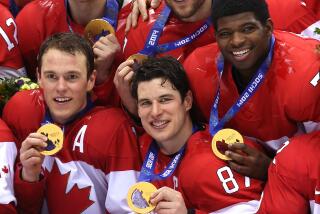League Ad Has People Talking
Call it “Desperate Body Checkers.”
Instead of wide receiver Terrell Owens and “Desperate Housewives” actress Nicollette Sheridan in a locker room, there’s an unknown actor being lovingly dressed in hockey gear by a starlet wearing a sexy dress and gauzy robe and speaking in breathless whispers.
“You ready?” she asks. “It’s time.”
Welcome to the new NHL, Hollywood-style.
This is the first installment of a new sort of advertising -- “brand storytelling” -- being used by the league in the frantic hope that a 310-day lockout and plummeting television ratings haven’t doomed the sport to niche status.
The branding campaign, which began airing last week and was geared to Wednesday’s season start, is out to fire up fans. But so far it has fired up critics, who find the ad campaign needlessly laced with sexual innuendo and violence.
Advertising experts, however, think some controversial oomph is just what the sport needs.
Looking for that oomph, the New York-based league came west, choosing a Santa Monica-based agency, Conductor, to reimagine and repackage the NHL’s image. The goal is to solidify the fan base -- the hard-core faithful -- and to attract new fans. The NHL is doing its part by changing some rules to bring faster, higher-scoring games. It also has added shootouts to eliminate tie games.
“We have got to get the casual sports fan,” said Tom Cotton, president of Conductor, which has created promotions for movies and music videos.
“Instead of using ad copywriters, you use screenwriting and filmmaking talent to tell a story,” he said. “You want to make a deep, emotional connection to the brand.”
The season-long campaign features five 30-second vignettes that tell a story, using cinematic effects such as odd angles and quick cuts.
It opens with a passage from the book “The Art of War” by Chinese military philosopher Sun Tzu: “A clever warrior is one who not only wins but excels at winning with ease.”
In the ad, a sensual young woman drapes hockey armor over the impossibly muscular chest of the glistening athlete. As she helps him don the gear, images flash in his mind -- of body checks and guttural roars from crowds.
The end of the first spot has the athlete walking confidently through the doors of what seems to be a locker room and onto the ice. The last face you see is of a young boy looking at the words “My NHL.”
Even before the first spot aired, it got Martha Burk’s attention. Burk, who led an unsuccessful effort to allow female members at Augusta National Golf Club three years ago, objected.
“They are selling sex and violence in a culture awash in sex and violence,” she told Bloomberg News. Five days later, the greeting on Burk’s cellphone said she preferred not to talk about the NHL. She returned an NHL call anyway.
“If I were a parent who was thinking of buying tickets to the NHL, I wouldn’t do it after I saw this commercial,” said Burk, chairwoman of the National Council of Women’s Organizations. “It markets violence. The last image you see is of a 10- or 11-year-old boy watching this with great glee. That’s offensive to me as a parent. I don’t think most parents appreciate that.”
Cotton defends his company’s approach.
“We wanted to portray a mythical shrine to hockey and sell the idea of these players as warriors,” he said. “The woman is a tough cookie. She is an equal to the player. She is his physical and spiritual trainer. If we were portraying this in some hyper-real way it would not be appropriate, but this is clearly a myth. What was Ms. Burk looking at?”
Cotton said that anyone who saw a resemblance to the NFL’s “Desperate Housewives” spot that caused an uproar last year is “way off-base.”
Bernadette Mansur, vice president of communications for the NHL, agreed.
“As a woman very involved with this process, I’m very surprised at this attitude. It’s all celebratory,” Mansur said. “The spot is very respectful of the woman. There is nothing that represents the woman as a sexual object.”
But Mike Bracko, the 46-year-old director of education at Calgary, Canada’s Institute for Hockey Research and an ex-hockey coach, equated the vignette to the NFL’s “Desperate Housewives” spot.
“I don’t think they’re going in the right direction, branding hockey with a phony warrior status,” he said. “And this commercial absolutely ... would not propel a family -- well, maybe if the father has high levels of testosterone -- to go to a hockey game so his kids could see scantily clad women, warriors and swords.”
But since Bracko, who loves the game, has figured out that hockey is being sold as mythical and filled with warriors means the campaign may be working, said Neal M. Burns, a University of Texas professor who studies product branding.
“What the NHL is branding is a sense of passion and loyalty to the game life force. Warriors do battle. Hockey players do battle. Essentially they are giving a new meaning and reason for why guys go out there and kill themselves. It’s for the adulation of the fans. It’s the idea: ‘We do it for you.’ ”
The NHL, more than any other professional league, relies on ticket sales as its main source of revenue. But it would like to change that.
Ratings for the Stanley Cup finals, the sport’s marquee event, have fallen four of the last five years to the point where ESPN didn’t even bid on a new contract. Now the majority of games will be on the Outdoor Life Network.
But the branding campaign could help.
“So much of advertising is just ignored,” Burns said. “I don’t think this is being ignored.”
Though NHL players seem to have accepted the campaign with good grace, King forward Jeremy Roenick had another reaction.
“At some point you see what something really is,” he said. “I’ll go on TV wearing a thong. More women will get interested and I’ll guarantee you no man is gonna sue.”
That might not be what Martha Burk had in mind. But Bracko said, “Geez, I just don’t get it. Here in Canada you could put a cow on skates and give him a stick and sell the game. It’s easy. But I guess I’m not who they’re aiming for. They want 18-year-old guys, and 18-year-old guys go for warriors and women, I guess.”
Times staff writer Chris Foster contributed to this report.
More to Read
Go beyond the scoreboard
Get the latest on L.A.'s teams in the daily Sports Report newsletter.
You may occasionally receive promotional content from the Los Angeles Times.






